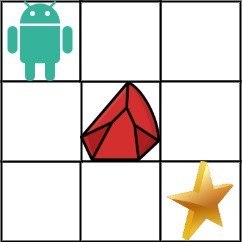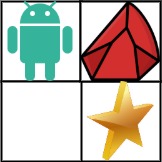source: https://leetcode.com/problems/unique-paths-ii/
C/C++ Solution to LeetCode problem 63. Unique Paths II.
Problem
You are given an m x n integer array grid. There is a robot initially located at the top-left corner (i.e., grid[0][0]). The robot tries to move to the bottom-right corner (i.e., grid[m - 1][n - 1]). The robot can only move either down or right at any point in time.
An obstacle and space are marked as 1 or 0 respectively in grid. A path that the robot takes cannot include any square that is an obstacle.
Return the number of possible unique paths that the robot can take to reach the bottom-right corner.
The test cases are generated so that the answer will be less than or equal to 2 * 109.
Examples
Example 1:
Input: obstacleGrid = [[0,0,0],[0,1,0],[0,0,0]]
Output: 2
Explanation: There is one obstacle in the middle of the 3x3 grid above.
There are two ways to reach the bottom-right corner:
- Right -> Right -> Down -> Down
- Down -> Down -> Right -> Right
Example 2:
Input: obstacleGrid = [[0,1],[0,0]]
Output: 1
Constraints
m == obstacleGrid.lengthn == obstacleGrid[i].length1 <= m, n <= 100obstacleGrid[i][j] is 0 or 1.
Solution
Same solution as for problem 62 with two differences:
- Check if the goal position has an obstacle.
- Need to check if the board/grid has a
1at the current position.
1
2
3
4
5
6
7
8
9
10
11
12
13
14
15
16
17
18
19
20
21
22
23
24
25
26
27
28
29
30
31
class Solution {
private:
vector<vector<int>> dp;
int paths(vector<vector<int>>& grid, int r, int c) {
if (r+1 == grid.size() && c+1 == grid[0].size())
return 1;
if (r == grid.size() || c == grid[0].size())
return 0;
if (grid[r][c] == 1)
return 0;
if (dp[r][c] != 0)
return dp[r][c];
dp[r][c] = 0;
dp[r][c] += paths(grid, r + 1, c);
dp[r][c] += paths(grid, r, c + 1);
return dp[r][c];
}
public:
int uniquePathsWithObstacles(vector<vector<int>>& obstacleGrid) {
if (obstacleGrid[obstacleGrid.size() - 1][obstacleGrid[0].size() - 1] == 1)
return 0;
dp = vector(obstacleGrid.size(), vector<int>(obstacleGrid[0].size(), 0));
return paths(obstacleGrid, 0, 0);
}
};


